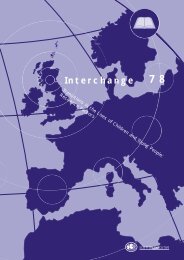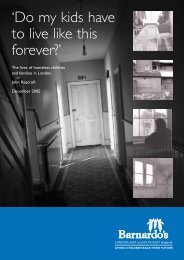Splintered Lives - Barnardo's
Splintered Lives - Barnardo's
Splintered Lives - Barnardo's
You also want an ePaper? Increase the reach of your titles
YUMPU automatically turns print PDFs into web optimized ePapers that Google loves.
PAGE 36<br />
chapter<br />
7<br />
There is only one police unit, in Greater Manchester, currently devoted to investigating<br />
computer porn (although two officers are responsible for this at OPS), and they seized<br />
8000 discs in one year (Ashley, 1993).<br />
The key issue involved in computer pornography is that the technology itself is<br />
extremely powerful. Transferring images to disc, means that the speed of copying and<br />
transmitting information can be fast and anonymous. Pornography can be 'down loaded'<br />
onto floppy discs which sell for as little as £1, or down loaded from other computers<br />
anywhere in the world using a modem telephone line. Current estimates are that 70% of<br />
computer porn is US based, and that much of the rest originates in Europe. One of the<br />
most frequent access points to computer pornography are bulletin boards - literally<br />
information screens which can be accessed through any of the so called 'information<br />
highway' networks. Some of these have apt names such as 'Flognet', 'Screwnet', and<br />
tracking them requires new forms of investigation/ policing. The other current shift in<br />
technology is CD ROM - CD discs which can store vast amounts of digitised information<br />
including still and moving images. The storage capacity of these discs is considerably<br />
greater than that of computer floppy discs, and many new computers include additional<br />
disc drives which can read CD ROM. One obvious implication is that more space will<br />
require more images to fill it, which in turn will result in more women and children'<br />
being used in the production process.<br />
This new technology means that many more copies of child pornography can be made.<br />
The technology now enables, and will increasingly do so, the manipulation of images<br />
on screen. It is already possible to superimpose children's heads on older bodies, or<br />
children's bodies onto adult faces, or to make adult bodies more child-like. The goal of<br />
virtual reality is for the user to be able to manipulate images on screen, to have 'control'<br />
over what happens. In order for this to be possible, original photographic or filmed<br />
images have to be scanned in, requiring, as with all pornography, real individuals. What<br />
the legal status of images which are constructed out of amalgams of real people, but<br />
where it is not clear what happened to whom in 'real life' and what was 'created' in<br />
virtual form, is likely to occupy lawyers for considerable time.<br />
Unlike photocopying or video copying where quality is lost as originals are copied, and<br />
the copies then copied, computerised information can be reproduced from copies of<br />
copies without loosing any quality. Moreover, it is simply not possible to limit children's<br />
access to computer pornography in the same ways that their access to pornography<br />
videos, films and magazines has been.<br />
In our' discussion with Michael Hames, then senior officer in OPS, he maintained there is<br />
no commercial child pornography market in Britain; its illegality has meant that it is not<br />
viable (although this fact has not produced that result in relation to drugs), and the<br />
Interpol network is very effective. Most British child pornography is home produced for<br />
individual use and that of close contacts. Having said this, however, Michael Hames, then<br />
noted a shift in the content of child pornography which OPS has discovered/seized;<br />
that it is following the pattern of adult porn with increasingly bizarre and violent
















